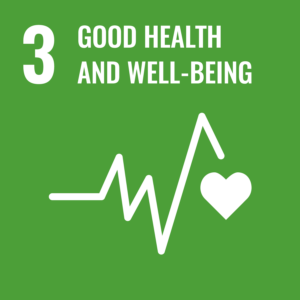
The COVID-19 pandemic has deeply impacted the tourism sector with a spill-over effect of unexpected socioeconomic consequences to many other sectors. The link between tourism and the importance of health and well-being has been highlighted even more during the pandemic as the sector depends on contact-intensive services – and restoring consumer confidence has been key to economic recovery of the tourism sector during the whole crisis. Consequently, a destination with clean and hygienic hotels, restaurants and other tourism facilities was in a better position to enhance its attractiveness. At the same time, tax generated from tourism activities as well as visitors’ fees collected in destinations can be reinvested in health care and services, improving maternal health, reducing child mortality and preventing diseases.
There are five targets within SDG 3 that are deemed to have a stronger and direct link for tourism to ensure healthy lives and promote well being for all at all ages. These targets have been selected to base the potential project indicators.
TARGET 3.3
BY 2030, END THE EPIDEMICS OF AIDS, TUBERCULOSIS, MALARIA AND NEGLECTED TROPICAL DISEASES AND COMBAT HEPATITIS, WATER-BORNE DISEASES AND OTHER COMMUNICABLE DISEASES.
According to World Health Organization (WHO) communicable diseases are caused by microorganisms such as bacteria, viruses, parasites and fungi that can be spread, directly or indirectly, from one person to another. Some are transmitted through bites from insects, while others are caused by ingesting contaminated food or water. This target stresses upon the implementation of appropriate health and safety plans including putting in place health and hygiene protocols. In this regard, tourism employers and workers should be aware of key hygiene and sanitation guidelines which are essential to prevent or halt the spread of communicable diseases and which also contribute to the coordination of a safe destination.
Potential indicators in this target are grouped by the following Theme and sub-theme
Health / Sanitation and hygiene protocols/ guidelines
Health / Health Guidelines
Health / Access to medicines and vaccines
Education and training / Capacity building
TARGET 3.6
BY 2020, HALVE THE NUMBER OF GLOBAL DEATHS AND INJURIES FROM ROAD TRAFFIC ACCIDENTS
The tourism sector relies heavily on good road and safety infrastructure for connectivity and, at the same time, it influences road infrastructure through intensive construction and modernization of the road network and means of transport. Target 3.6 calls for good road safety to guarantee the safety of local residents and at the same time improve their mobility. In tourism destinations, as tourists are fellow road users, the reduction in road accidents requires awareness of the importance of road safety by everyone, including residents and tourists. Tourism stakeholders, together with public and private entities, should work together to ensure the applicability of road safety policies, maintenance of the road network and awareness raising actions and preventive measures
Potential indicators in this target are grouped by the following Theme and sub-theme
Infrastructure / Transport
Infrastructure / Traffic and mobility plan
Legal frameworks, policies and rule of law / Tourism policies and strategies
Education and training / Capacity building
TARGET 3.8
ACHIEVE UNIVERSAL HEALTH COVERAGE, INCLUDING FINANCIAL RISK PROTECTION, ACCESS TO QUALITY ESSENTIAL HEALTH-CARE SERVICES AND ACCESS TO SAFE, EFFECTIVE, QUALITY AND AFFORDABLE ESSENTIAL MEDICINES AND VACCINES FOR ALL.
Tourism’s contribution to this target can be seen in various ways, including investing in health-care activities such as health insurance for employees, thus making sure that a part of the population has access to essential health care. In destinations where tourism is one of the main sources of employment, the impact is more visible. In tourism destinations where tourism tax revenues are specifically assigned, to advocate for such tax from tourism, fees and charges from visitors to be reinvested into health care, services and disease prevention. This is particularly relevant in destinations that are highly dependent on tourism and where appropriate medical facilities will help to attract more tourists.
Potential indicators in this target are grouped by the following Theme and sub-theme
Health / Health protection
Health / Access to medicines and vaccines
TARGET 3.9
BY 2030, SUBSTANTIALLY REDUCE THE NUMBER OF DEATHS AND ILLNESSES FROM HAZARDOUS CHEMICALS AND AIR, WATER AND SOIL POLLUTION AND CONTAMINATION.
Target 3.9 looks at reducing illnesses and death from hazardous chemicals and pollution. By decreasing the environmental impact of the tourism sector and introducing sustainable practices, it can contribute to a reduction in deaths and illnesses. As Target 3.9 is closely related to Goals 6, 7 and 13, further information and more specific indicators, related to air quality, food security, water quality and waste reduction will be presented under these goals.
Potential indicators in this target are grouped by the following Theme and sub-theme
Legal frameworks, policies and rule of law / Tourism policies and strategies
Sustainable consumption and production patterns / Sustainable operations
Target 3.d
STRENGTHEN THE CAPACITY OF ALL COUNTRIES, IN PARTICULAR DEVELOPING COUNTRIES, FOR EARLY WARNING, RISK REDUCTION AND MANAGEMENT OF NATIONAL AND GLOBAL HEALTH RISKS
Target 3.d has been further highlighted due to the COVID-19 pandemic as it calls for a strong early warning system, and management of national and global health risks. The pandemic has underscored the crucial importance of better management of global health risks, especially in developing countries, and in this regard, tourism can contribute to Target 3.d. Tourism can promote and integrate disaster risk management approaches throughout the sector, given the often-heavy reliance on tourism as a key economic driver in developing countries. Both public and private sectors should have/build the capacity to prevent, manage, adjust and adapt to different shocks, disasters and health risks.
Potential indicators in this target are grouped by the following Theme and sub-theme:
Crisis management / Disaster risk reduction
Crisis management / Crisis strategies and plan
Education and training / Capacity building
Health / Health protection
Health / Access to medicines and vaccines

